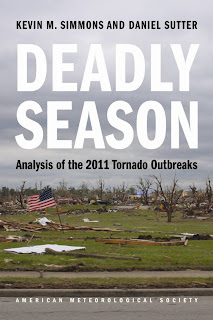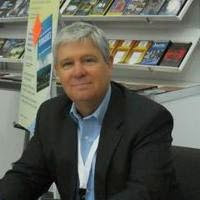Dan Sutter and I have a new book released this week from AMS Books and the University of Chicago Press. You can order the book from AMS Books at:
Friday, April 6, 2012
Wednesday, April 4, 2012
A Tornado Visits My Hometown
I’m an economist who studies natural hazards. Over the last few years, tornadoes have dominated that research agenda. It’s a fascinating topic for social scientists and most of the time I can separate the emotions of a horrifying event allowing me to conduct dispassionate analysis. But yesterday the research came home. Both my wife and I went to high school in Arlington, Texas. Most people know Arlington as the home of the Texas Rangers, Six Flags and now the Dallas Cowboys. But for those of us who were raised there, it’s home like any town is home. We know the streets, not as markers on a map but places in our lives. We remember when the mall was an open field as well as the name of the local college before it was subsumed into one of the state university systems. As I was watching TV coverage of the tornadoes, it became clear that my home town had been struck by the very monster I have spent the last 10 years studying. It’s not the first tornado to hit Arlington, or the DFW metroplex, for that matter, but it was the first time since the incredible and horrifying death toll from last year’s tornado season. It also happened as the National Weather Service is conducting an effort, known as Weather Ready Nation, to help prepare for future outbreaks. I’ve been involved in that effort and I have no doubt that yesterday’s outbreak will become one of the talking points. The main point for the researcher in me is that a tornado outbreak hit a major population area and as of now, there are no fatalities. Over 6 million people live in the Dallas/Ft. Worth metropolitan area. By some estimates somewhere between 6 and 12 tornadoes touched down, some large enough to send 5 ton tractor trailers into the air like match sticks. Significant to major damage occurred in Kennedale, Arlington, Lancaster and Forney, all suburbs on the southern and eastern side of the DFW metroplex but across a 50 mile swath. This is the nightmare scenario that keeps forecasters and emergency managers up at night. And when the previous season saw death tolls in the hundreds, it brings a keen focus to bear. Teams of engineers will descend on my home town in the ensuing days to assess the storm path and damage. They should talk to Dale Stubblefield, who went to high school with my wife and me. He posted an eye witness account on Facebook with a description of the path, the damage he witnessed but most importantly the speed with which the neighborhood began the process of recovery.
“The damage to the neighborhood is heart breaking. We were lucky and had minor damage, a broken window, some roof damage, we lost a tree and our fence. Our neighborhood got nailed. The tornado crossed 287 at Sublett, turned north and passed Corey Elementry creating havoc. It crossed I-20 and blew up homes as it headed to St. Barnabus Church up on the hill. The pre-school was in session with over 85 kids as the storm ripped off the roof of the chuch education building and then ripped though my neighborhood before hitting a nursing home on Green Oaks.
Help was immediate. The Martin HS football team came in by the truckloads and started stacking fence panels, moving brush and helping a family move their valuables out of their home. Members of St. Barnabus, even though their church had been heavily damaged brought food and drinks to those working to secure homes. Wow - what a day.”
Help was immediate. The Martin HS football team came in by the truckloads and started stacking fence panels, moving brush and helping a family move their valuables out of their home. Members of St. Barnabus, even though their church had been heavily damaged brought food and drinks to those working to secure homes. Wow - what a day.”
Subscribe to:
Comments (Atom)


